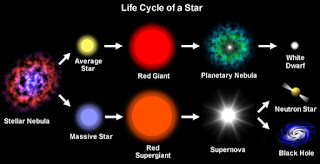CHEMISTRY OF THE UNIVERSE— PART 2
Simply put, the interstellar medium is the material which fills the space between the stars. Many people imagine outer space to be a complete vacuum devoid of any material. Although the interstellar regions are more devoid of matter than any vacuum artificially created on Earth, there is matter in space. These regions have very low densities and consists mainly of gas (99%) and dust. In total, approximately 15% of the visible matter in the Milky Way Galaxy composed of interstellar gas and dust.
Interstellar Gas
Approximately 99% of the interstellar medium income is composed of interstellar gas, and of its mass, about 75% is in the form of hydrogen (either molecular or atomic), with the remaining 25% as helium. The interstellar gas consists partly of neutral atoms and molecules, as well as charged particles, such as ions and electrons. This gas is extremely dilute, with an average density of about 1 atom per cubic metre (for example, the air we breathe bas a density of 30,000,000,000,000,000,000 molecules per cubic metre). Even though the interstellar gas is very dilute, the amount of matter adds up over the vast distances between the stars. The interstellar gas is typically found in two forms:
1. Cold clouds of neutral or molecular hydrogen; and
2. Hot ionized hydrogen near hot young stars.
 |
| Horse Head NEBULA! |
The cold clouds of neutral or molecular hydrogen are the birthplace of new stars if they become gravitationally unstable and collapse. The neutral and molecular forms emit radiation in the radio band of the electromagnetic spectrum. The ionized hydrogen is produced when large amount of ultraviolet radiation are released by hot newly-formed stars. This radiation ionises the surrounding clouds of gas. Visible light is emitted when electrons recombine with the ionized hydrogen which is seen as beautiful red colour of emission nebulae. Examples of emission Nebula are the Trifid Nebula or the Orion Nebula (seen in this photograph).
 |
| Reflection NEBULA |
✓ the Interstellar Medium also has dense, cool regions where molecules can be found called Molecular Clouds.
✓ Temperature less than 100K.
✓ Molecules detected include: H2 (hydrogen), CO (carbon monoxide), H2O (water), C2H5OH (ethanol) and other complex organic molecules.
✓ Density of molecules in this room: 2*10^25 molecules per cubic metre.
✓ Density of molecules in a molecular cloud: 109 molecules per cubic metre.
Buy Tshirts now at best deals.
How Do Stars Form?
Stars from inside, relatively dense concentrations of interstellar gas and dust known as Molecular Clouds. These regions are extremely cold (temperature about 10 to 20K, just above absolute zero). At these temperatures, gases become molecular, meaning that atoms bind together. CO and H2 are the most common molecules in the interstellar gas clouds. The deep cold also causes the gas to clump to high densities. When the density reaches a certain point, stars form.
Change the regions are dense, they are opaque to visible light and are known as dark nebula. Since they don't shine by optical light, we must use IR and radio telescopes to investigate them.
Star formation begins with the denser parts of the cloud core collapse under their own weight/gravity. These cores typically have masses around 104 solar masses in the form of gas and dust. The cores are denser than the outer cloud, so they collapse first. As the cores collapse, they fragment into clumps around 0.1 parsecs in size and 10 to 50 solar masses in mass. These clumps then form into protostars and the whole process takes about 10 million years.
How do we know this is happening if it takes so long and is hidden from view in dark clouds? Most of these cloud cores have IR sources coma evidence of energy from collapsing protostars (potential energy converted into kinetic energy). Also, where do we find young starts, we find them surrounded by a cloud of gas, the leftover dark molecular cloud. And they occur in clusters, groups of stars that form from the same cloud core.
The evolution of young stars is from a cluster of protostars deep in a molecular cloud's core, to a cluster of ,T-Tauri stars whose hot surface and Stellar winds heat the surrounding gas to form and HII region (HII, pronounced H-two means ionized hydrogen). Later the cluster breaks out, the gas is blown away, and the stars evolve as shown in the picture above.
Often in galaxies we find clusters of young stars near other young stars. This phenomenon is called Supernova induced star formation. The very massive stars form first and explode into supernova. This makes shock waves into the molecular cloud, causing nearby gas to compress and form more stars. This allows a type of Stellar coherence (young stars are found near other young stars) to build up, and is responsible for the pinwheel patterns we see in galaxies.
Learn about Postural deformity and corrective measures here in detail.









Comments
Post a Comment